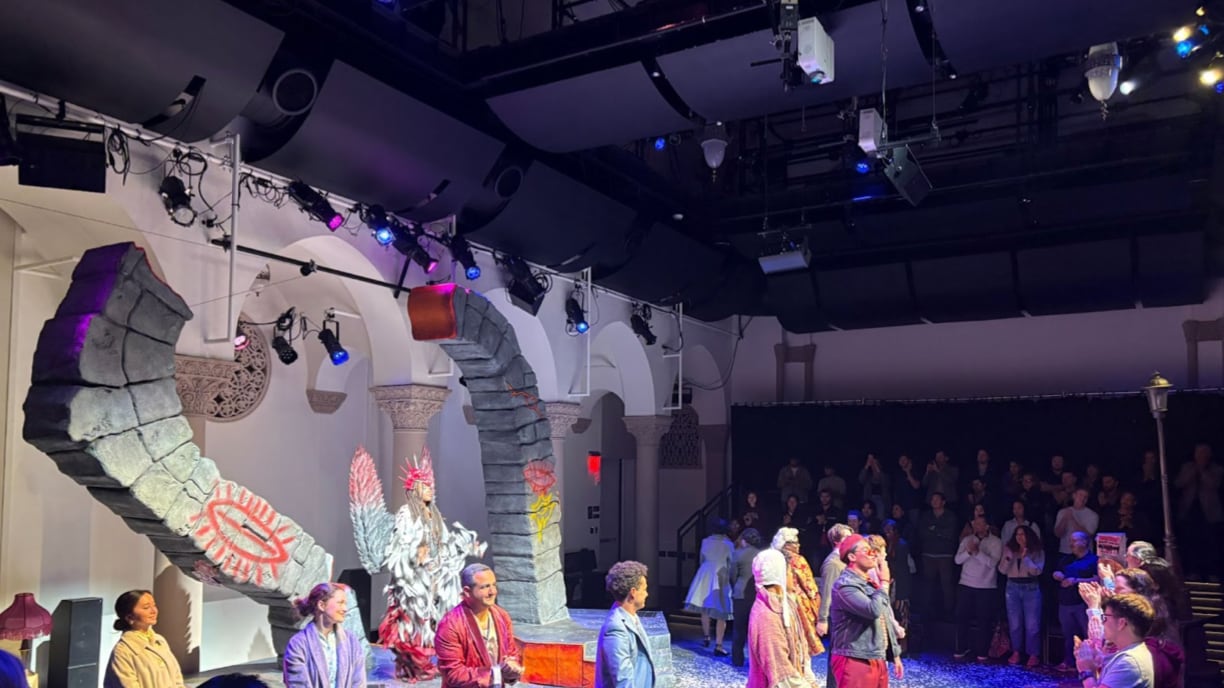Before there was “Harry Potter and the Cursed Child,” Tony Kushner’s Pulitzer Prize-winning play “Angels in America” popularized the infamous yet rare two-part play. Both parts of the show opened on Broadway in 1993 with “Millennium Approaches” hitting the stage six months before its bookend, “Perestroika.” SDA’s current production only stages the first half; when produced as one work, the combined production contains five acts and runs for roughly seven hours. To say that the show is a marathon is far less hyperbolic than one may assume.
The play is among many works of theatre from the 1980s and 1990s to use the stage as a form of protest, as New York City was experiencing the lethal combination of the devastating HIV/AIDS epidemic and an apathetic government, a pairing that is still prevalent thirty years later. The plot of “Angels in America: Millennium Approaches” acquaints the audience with five characters sprawled out across 1985′s New York from the Bronx to Brooklyn, intertwining storylines as they all struggle with love, disease, sexuality and success as the new millennium approaches.
As for SDA’s rendition of the play directed by John DeMita, I have nothing but compliments for the production.
The venue contains a thrust stage, where the audience members surround the central performers on three sides, leaving the fourth for a beautifully crafted and versatile archway. A staging of this kind could lead to complications in ensuring that all audience members have a view of the action, but the actors’ blocking was completely seamless and allowed for every facial expression to be seen, even from my side seat.
A particular standout moment in blocking comes in a scene in the second act with characters Prior Walter (Caleb Kocsis), Louis Ironson (Riley Skinner), Harper Pitt (Ella Davis) and Joseph Pitt (Landon Robinson). While Prior and Louis’s exchange is clearly separate from that of Harper and Joseph’s, the couples are positioned at different corners of the room across from their counterparts. As the scene begins, both Louis and Joseph traverse the stage towards their respective partners effortlessly. They never acknowledge each other’s presence even when they cross paths, further clarifying to the audience that, while the two actors are standing in the same space mere feet apart, their characters are not.
The lighting throughout the show was also incredible. Designed by SDA sophomore and theatre major Charlotte Baklarz, it supports the production remarkably, whether it be the differentiation in cool- and warm-toned spotlights or the final splashes of color before the third act closes, it truly enhances the show without pulling the audience’s focus.
In a similar vein, the set arrangements were absolutely amazing. From the stationary arch that remains throughout the performance, to the slew of literal moving parts that transitioned on and off the stage by stagehands, the care with which this production was handled is evident everywhere.
Every individual in this cast* of SDA seniors committed wholeheartedly to their performances, I was swept away by their inescapable sincerity and vulnerability on stage. Notably, Caleb Kocsis as Prior Walter is a marvel throughout the show — exuding fantastic flamboyance when appropriate, yet also capturing the tenderness of the character in quieter moments. Not to mention, his chemistry with Riley Skinner as Louis Ironson is palpable, as Skinner delivers a confident and sincere performance of the somewhat erratic character.
Adrian Quinonez as Roy Cohn is absolutely exceptional, as one of the few cast members burdened with portraying a real person. He captures the hunger and ferocity of Cohn with a breath of individuality, a task that is no small feat given the abundance of attention that Cohn has received in recent media.
Landon Robinson and Ella Davis as Joseph and Harper Pitt, respectively, play a convincing married Mormon couple, as Joseph wrestles with his sexuality and Harper with a Valium addiction. Together, the pair is fantastic at balancing one another’s energy. Robinson has his footing on Joseph’s high-strung yet emotional demeanor, and Davis truly takes the viewer on a journey into Harper’s mind.
I would also like to extend kudos to the supporting cast members, many of whom shoulder several roles in the production with ease. Standouts for me included Aneesa Monét as Henry and KJ Odea as Belize.
Monét shares a scene with Quinonez just before the first intermission where their character, Henry (Roy’s doctor), delivers devastating and regrettable news to the New York lawyer. The weight of the scene undoubtedly contributes to its memorability, but Monét’s performance and delivery are undeniably spectacular as well. The pair brilliantly balances the gravity of the scene’s message with the weight of its modern relevance, that nobody is immune to disease, not even those with the “clout” of Roy Cohn.
Odea, as Belize, was also phenomenal in his scene with Riley Skinner. As Louis rambles on in what starts as a one-sided political monologue, you can’t help but acknowledge Odea’s natural talent for physical acting and comedy. When it eventually did come time for Odea to speak, he played into the audience’s energy as a tour-de-force in engaging the crowd.
In all honesty, my only wish for the show is that there were more seats in the venue to allow more audiences the privilege of witnessing the production.
Angels in America is a very highly acclaimed piece of theatre, famed for its pairing of witty dialogue with heart-wrenching realities. It is clear that everyone involved in SDA’s staging felt the importance of the story, both in history and in the present.
The play turns the theatre into a classroom, projecting forgotten stories as it reminds us of America’s turbulent history and how close we have come to repeating it.
*Actors may differ depending on the performance. For more information about the cast, click here.
“Angels in America, Part One: Millennium Approaches” is playing through April 27 at Sanctuary Theatre. Tickets start at $10 for USC students; $20 for non-USC students. For more information, click here.
